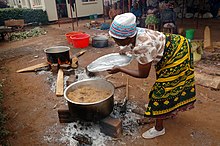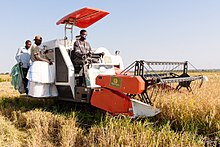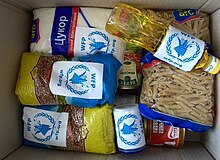ටැන්සානියාවේ ආහාර සහ පෝෂණය

දුර්වල පෝෂණය ටැන්සානියාව තුළ නිරන්තර ගැටලුවක් වන අතර රටේ ප්රදේශ පුරා විශාල වශයෙන් වෙනස් වේ. USAID වාර්තා කරන පරිදි ළමුන්ගෙන් 16% ක් අඩු බරින් යුක්ත වන අතර 34% ක් මන්දපෝෂණයේ ප්රතිඵලයක් ලෙස වර්ධනය අඩාල වී ඇත.[1] කලාප 10ක 58%ක වර්ධනය අඩාල වූ දරුවන් සිටින අතර උග්ර මන්දපෝෂණයෙන් පෙළෙන දරුවන්ගෙන් 50%ක් කලාප 5කින් සොයාගත හැකිය.[2] වසර 5 ක කාලයක් තුළ, ටැන්සානියාවේ මාරා දිස්ත්රික්කයේ වයස අවුරුදු 5 ට අඩු ළමුන්ගේ වර්ධනය 15% කින් අඩු වී ඇති අතර, 2005 සහ 2010 දී පිළිවෙලින් 46% සිට 31% දක්වා පහත වැටුණි. අනෙක් අතට, ඩොඩෝමා මෙම වයස් කාණ්ඩයේ වර්ධනය 7% කින් වර්ධනය වූ අතර, 2005 දී 50% සිට 2010 දී 57% දක්වා වැඩි විය.[3] සමස්ත ආහාර ලබා ගැනීමේ හැකියාව සමස්ත පල්වීමේ සංඛ්යා සඳහා අවශ්යයෙන්ම දායක නොවේ. සමස්ත ආහාර ලබා ගැනීම පිළිගත හැකි යැයි සැලකෙන ඉරිංගා, ඹේයා සහ රුක්වා ප්රදේශ තවමත් 50% ඉක්මවන කුරුටු වීම්වලට මුහුණ දෙයි. ටැබෝරා සහ සින්ගිද ප්රදේශ වැනි ආහාර හිඟය බහුලව පවතින සමහර ප්රදේශවල, ඉරිංගා, ම්බෙයා සහ රුක්වා යන ප්රදේශවල දක්නට ලැබෙන ප්රමාණයට වඩා අඩුවෙන් පවතින අවස්ථා තිබේ.[3] ටැන්සානියාවේ ආහාර සහ පෝෂණ මධ්යස්ථානය මෙම විෂමතාවයන් මාතෘ මන්දපෝෂණය, දුර්වල ළදරු ආහාර පිළිවෙත්, සනීපාරක්ෂාව පිළිවෙත් සහ දුර්වල සෞඛ්ය සේවා වැනි වෙනස්කම් වලට හේතු වේ.[3] නියඟ කාල සීමාවන් ටැන්සානියාවේ බෝග නිෂ්පාදනය කෙරෙහි සැලකිය යුතු බලපෑමක් ඇති කළ හැකිය. නැගෙනහිර අප්රිකාවේ නියඟය හේතුවෙන් ටැන්සානියාවේ ජනගහනයෙන් බහුතරයකගේ පෝෂණයට තීරණාත්මක වන බඩඉරිඟු සහ බඩ ඉරිඟු වැනි ආහාර ද්රව්යවල මිල විශාල ලෙස ඉහළ ගොස් තිබේ. 2015 සිට 2017 දක්වා බඩ ඉරිඟු තොග මිලට ගත් විට කිලෝග්රෑමයකට ටැන්සානියානු සිලිං 400/= සිට 1,253/= දක්වා තුන් ගුණයකින් වැඩි විය.[4]

ටැන්සානියාව දැඩි ලෙස කෘෂිකාර්මික ලෙස පවතී, මුළු ජනගහනයෙන් 80% ක් යැපුම් ගොවිතැනෙහි නියැලී සිටිති.[4] නාගරීකරණය වූ ප්රදේශවලට සාපේක්ෂව ග්රාමීය ප්රදේශ වැඩි ආහාර හිඟයකට ලක්ව ඇති අතර, 2017 දී රට තුළ සිදු කරන ලද සමීක්ෂණයකින් ග්රාමීය ප්රදේශවල ජනතාවගෙන් 84% ක් මාස 3 ක කාලයක් තුළ ආහාර හිඟයෙන් පෙළෙන බව සොයා ගත් අතර නගරවල පදිංචිකරුවන්ගෙන් 64% ට සාපේක්ෂව.[4] ග්රාමීය සහ නගර පෝෂණය අතර මෙම විෂමතාවය විවිධ සාධකවලට හේතු විය හැක; ශ්රමික ශ්රමය හේතුවෙන් පෝෂණ අවශ්යතා වැඩි වීම, දුර්වල යටිතල පහසුකම් හේතුවෙන් ආහාර සඳහා ඇති සීමිත ප්රවේශය, ස්වභාවධර්මයේ හානිදායක බලපෑම් සහ "කෘෂිකාර්මික ඵලදායිතා පරතරය" සඳහා ඉහළ සංවේදීතාවයක් ඇති වීම.[5] කෘෂිකාර්මික ඵලදායිතා පරතරය, කෘෂිකාර්මික අංශය තුළ "එක් සේවකයෙකුට එකතු කළ අගය" බොහෝ විට කෘෂිකාර්මික නොවන අංශවල දක්නට ලැබෙන ප්රමාණයට වඩා බෙහෙවින් අඩු බව උපකල්පනය කරයි. තවද, කෘෂිකාර්මික අංශය තුළ ශ්රම වෙන් කිරීම බොහෝ දුරට අකාර්යක්ෂම ලෙස වෙන් කරනු ලැබේ.[6]
කුසගින්න ඉලක්ක කරගත් වැඩසටහන්
[සංස්කරණය]පෝෂණය පිළිබඳ අවධානය යොමු කරන USAID වැඩසටහන් ටැන්සානියාවේ මොරොගෝරෝ, ඩොඩෝමා, ඉරිංගා, ඹේයා, මාන්යාරා, සොන්ග්වේ සහ සැන්සිබාර් ප්රදේශ තුළ ක්රියාත්මක වේ. මෙම "Feed the Future" වැඩසටහන් පෝෂණය, යටිතල පහසුකම්, ප්රතිපත්ති, ආයතනවල ධාරිතාව සහ කෘෂිකර්මාන්තය සඳහා විශාල වශයෙන් ආයෝජනය කරයි, එය සංවිධානය විසින් රටේ ආර්ථික වර්ධනයේ ප්රධාන ක්ෂේත්රයක් ලෙස හඳුනාගෙන ඇත.[1] ටැන්සානියානු රජය විසින් මෙහෙයවන ලද "කිලිමෝ ක්වන්සා" හෝ "පළමුව කෘෂිකර්මය" මුලපිරීමේ අරමුණ වන්නේ පුද්ගලික අංශය තුළ කෘෂිකර්මාන්තය සඳහා ආයෝජන දිරිමත් කිරීම සහ තරුණ තරුණියන්ගේ දැනුම සහ ඔවුන්ට ලබා දිය හැකි නවෝත්පාදනයන් සෙවීමෙන් රට තුළ කෘෂිකාර්මික ක්රියාවලීන් සහ සංවර්ධනය වැඩිදියුණු කිරීමට බලාපොරොත්තු වේ.[7] 1990 ගණන් වලදී, ටැන්සානියාවේ ජනගහනයෙන් 25% කට පමණ, අනාගත මව්වරුන් තුළ අයඩින් ඌනතාවය ඉලක්ක කර ගැනීම සඳහා අයඩින් සහිත තෙල් සඳහා ප්රවේශය ලබා දෙන ලදී, අධ්යයනයන්හි ප්රතිඵලයක් ලෙස, ගර්භාෂ අයඩින් ඌනතාවය දරුවන්ගේ සංජානන වර්ධනයට අහිතකර බලපෑම් පෙන්නුම් කරයි. අධ්යයනයෙන් පෙන්නුම් කළේ අතිරේකය සඳහා ප්රවේශය ඇති මව්වරුන්ගේ දරුවන් සාමාන්යයෙන් වසරකට තුනෙන් එකකට වඩා වැඩි අධ්යාපනයක් ලබා නොගත් අයට වඩා වැඩි බවයි.[7]

ලෝක ආහාර වැඩසටහන මගින් මෙහෙයවනු ලබන වැඩසටහන් ටැන්සානියාව තුළ ක්රියාත්මක වේ. පරිපූරක පෝෂණ වැඩසටහන (SFP) ගර්භනී කාන්තාවන්ට සහ අවුරුදු 5 ට අඩු දරුවන්ට විටමින් මිශ්ර කළ ආහාර මාසිකව සැපයීම මගින් උග්ර මන්දපෝෂණය ඉලක්ක කර ගැනීම අරමුණු කරයි.[8] ගැබිනි කාන්තාවන් සහ අවුරුදු 2 ට අඩු ළමුන්ගේ සිට දරුවන්ගේ කුරුවීම අවම කිරීමේ අරමුණින් සපයනු ලබන මව සහ ළමා සෞඛ්ය සහ පෝෂණ වැඩසටහනේ "සුපිරි ධාන්ය" වෙත ප්රවේශය ඇත.[8] ලෝක ආහාර වැඩසටහනේ අතිරේකය ටැන්සානියාවේ සරණාගතයින් සඳහා ප්රධාන ආහාර ප්රභවය ලෙස පවතී. සාමාන්ය පුද්ගලයෙකුගේ අවම දෛනික කැලරි අවශ්යතාවය වන 2,100 සපුරාලීම සඳහා දිගුකාලීන සහන සහ ප්රතිසාධන මෙහෙයුමේ කොටසක් ලෙස සුපිරි ධාන්ය, එළවළු තෙල්, ධාන්ය වර්ග සහ ලුණු සපයනු ලැබේ.[8] ටැන්සානියාව තුළ පෝෂණය සඳහා අඛණ්ඩව ආයෝජනය කිරීම අතිශයින්ම වැදගත් බව යුනිසෙෆ් ප්රකාශ කරයි: රට තුළ පෝෂණය වර්තමාන මට්ටමේ පැවතුනහොත් 2025 වන විට ටැන්සානියාවට ඩොලර් බිලියන 20 ක් අහිමි වනු ඇතැයි ඇස්තමේන්තු අනාවැකි පළ කරයි, කෙසේ වෙතත් පෝෂණය වැඩිදියුණු කිරීමෙන් ඩොලර් බිලියන 4.7 ක පමණ ලාභයක් ලබා ගත හැකිය.[2]
UNICEF සහ අයර්ලන්ත ආධාර අරමුදල්වල සහය ඇතිව Save the Children, 2011 දී ටැන්සානියාවේ පෝෂණය සඳහා හවුල්කාරිත්වය (PANITA) නිර්මාණය කළේය. PANITA හි අරමුණ වන්නේ රට තුළ පෝෂණය ඉලක්ක කර ගැනීම සඳහා සිවිල් සමාජ සංවිධාන භාවිතා කිරීමයි. මෙයට සමගාමීව කෘෂිකර්මය, ජලය, සනීපාරක්ෂාව, අධ්යාපනය, ආර්ථික සංවර්ධනය සහ සමාජ ප්රගතිය වැනි පෝෂණය හා සම්බන්ධ විවිධ අංශ ඉලක්ක කර ඇත. ටැන්සානියාව තුළ ජාතික සහ කලාපීය මට්ටමින් නිර්මාණය කරන ලද සංවර්ධන සැලසුම් සහ අයවැය තුළ පෝෂණය කෙරෙහි සැලකිය යුතු අවධානයක් ලබා දීම සහතික කිරීම සඳහා PANITA වගකීම දරයි. එහි සංකල්පයේ සිට, PANITA රට පුරා සිවිල් සමාජ සංවිධාන 94 සිට 306 දක්වා වර්ධනය වී ඇත.[9] ටැන්සානියාව තුළ කෘෂිකර්මාන්තය ඉලක්ක කරගනු ලබන්නේ, රටේ ලින්ඩි දිස්ත්රික්කයේ කෘෂිකර්මාන්තය සමඟ පෝෂණ මූලාරම්භයන් ඒකාබද්ධ කිරීම අරමුණු කරගත්, පෝෂණ ප්රතිඵල සඳහා කෘෂිකර්මාන්තය උපයෝගී කර ගැනීමේ Irish Aid ප්රමුඛ මුලපිරීම (HANO) මගිනි. මෙම ව්යාපෘතිය මාස 0 සිට 23 දක්වා ළමුන්ගේ වයස 10% කින් අඩු කිරීම අරමුණු කරයි.[9]
යොමු කිරීම්
[සංස්කරණය]- ^ a b "Tanzania: Nutrition Profile". usaid.gov (ඉංග්රීසි බසින්). 24 October 2018 දින මුල් පිටපත වෙතින් සංරක්ෂණය කරන ලදී. සම්ප්රවේශය 18 October 2018.
- ^ a b "UNICEF Tanzania—Nutrition—The situation". unicef.org. 2 January 2019 දින මුල් පිටපත වෙතින් සංරක්ෂණය කරන ලදී. සම්ප්රවේශය 28 October 2018.
- ^ a b c "Tanzania Assessment for Scaling Up Nutrition" (PDF). 2012. 2 March 2021 දින මුල් පිටපත (PDF) වෙතින් සංරක්ෂණය කරන ලදී. – via World Health Organization.
- ^ a b c Makoye, Kizito. "Survey finds most Tanzanians go hungry, despite government denials". Reuters. සම්ප්රවේශය 20 November 2018.
- ^ Alphonce, Roselyne (2017). "Addressing the mismatch between food and nutrition policies and needs in Tanzania" (PDF). Brookings.
- ^ Gollin, Douglas; Lagakos, David & Waugh, Michael E. (November 2013). "The Agricultural Productivity Gap" (PDF). National Bureau of Economic Research.
- ^ a b "African Human Development Report 2012" (PDF). 2012. pp. 80, 93. 10 December 2019 දින මුල් පිටපත (PDF) වෙතින් සංරක්ෂණය කරන ලදී. සම්ප්රවේශය 5 December 2018 – via United Nations Development Programme.
- ^ a b c "UN World Food Programme" (ඉංග්රීසි බසින්). 6 December 2018 දින මුල් පිටපත වෙතින් සංරක්ෂණය කරන ලදී. සම්ප්රවේශය 8 November 2018.
- ^ a b "Nutrition | Tanzania | Save the Children". tanzania.savethechildren.net (ඉංග්රීසි බසින්). 6 December 2018 දින මුල් පිටපත වෙතින් සංරක්ෂණය කරන ලදී. සම්ප්රවේශය 14 November 2018.
